Semester 1 BMP4005: IT Solutions & Big Data Analysis Exam 2021/22
VerifiedAdded on 2023/06/08
|7
|2810
|370
Homework Assignment
AI Summary
This assignment solution for the Information System & Big Data Analysis (BMP4005) exam covers various topics, including the development and design of IT solutions like Moodle and Canvas, and provides explanations with examples for Decision Support Systems (DSS), Executive Support Systems (ESS), Transaction Processing Systems (TPS), Management Information Systems (MIS), and Knowledge Management Systems (KMS). It also discusses globalization and the effects of IT on globalization, defining digital infrastructure with examples such as the Internet Backbone and Broadband, along with their respective advantages and disadvantages. The document gives a detailed insight into each topic with result-oriented terms.
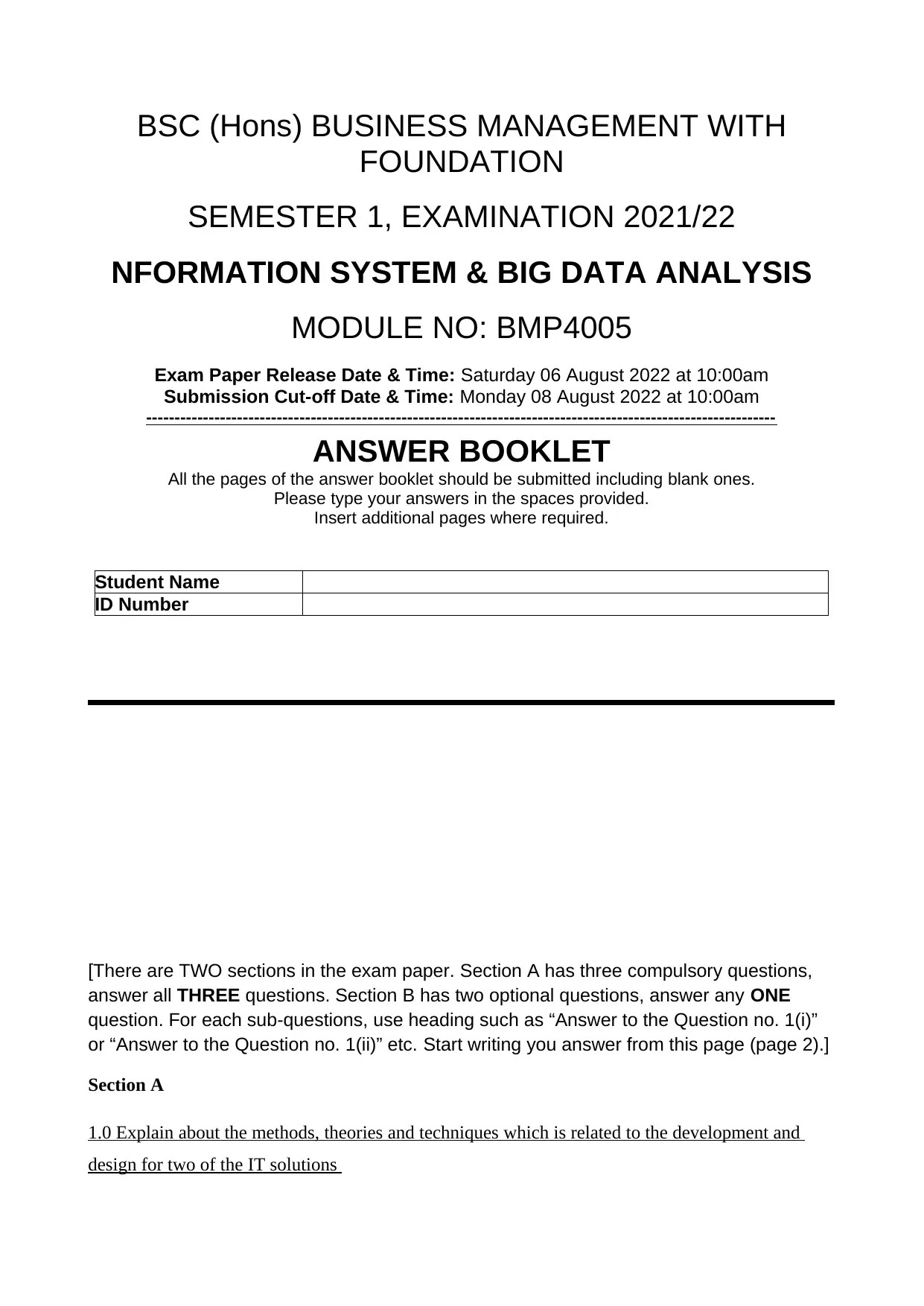
BSC (Hons) BUSINESS MANAGEMENT WITH
FOUNDATION
SEMESTER 1, EXAMINATION 2021/22
NFORMATION SYSTEM & BIG DATA ANALYSIS
MODULE NO: BMP4005
Exam Paper Release Date & Time: Saturday 06 August 2022 at 10:00am
Submission Cut-off Date & Time: Monday 08 August 2022 at 10:00am
---------------------------------------------------------------------------------------------------------------
ANSWER BOOKLET
All the pages of the answer booklet should be submitted including blank ones.
Please type your answers in the spaces provided.
Insert additional pages where required.
Student Name
ID Number
[There are TWO sections in the exam paper. Section A has three compulsory questions,
answer all THREE questions. Section B has two optional questions, answer any ONE
question. For each sub-questions, use heading such as “Answer to the Question no. 1(i)”
or “Answer to the Question no. 1(ii)” etc. Start writing you answer from this page (page 2).]
Section A
1.0 Explain about the methods, theories and techniques which is related to the development and
design for two of the IT solutions
FOUNDATION
SEMESTER 1, EXAMINATION 2021/22
NFORMATION SYSTEM & BIG DATA ANALYSIS
MODULE NO: BMP4005
Exam Paper Release Date & Time: Saturday 06 August 2022 at 10:00am
Submission Cut-off Date & Time: Monday 08 August 2022 at 10:00am
---------------------------------------------------------------------------------------------------------------
ANSWER BOOKLET
All the pages of the answer booklet should be submitted including blank ones.
Please type your answers in the spaces provided.
Insert additional pages where required.
Student Name
ID Number
[There are TWO sections in the exam paper. Section A has three compulsory questions,
answer all THREE questions. Section B has two optional questions, answer any ONE
question. For each sub-questions, use heading such as “Answer to the Question no. 1(i)”
or “Answer to the Question no. 1(ii)” etc. Start writing you answer from this page (page 2).]
Section A
1.0 Explain about the methods, theories and techniques which is related to the development and
design for two of the IT solutions
Paraphrase This Document
Need a fresh take? Get an instant paraphrase of this document with our AI Paraphraser
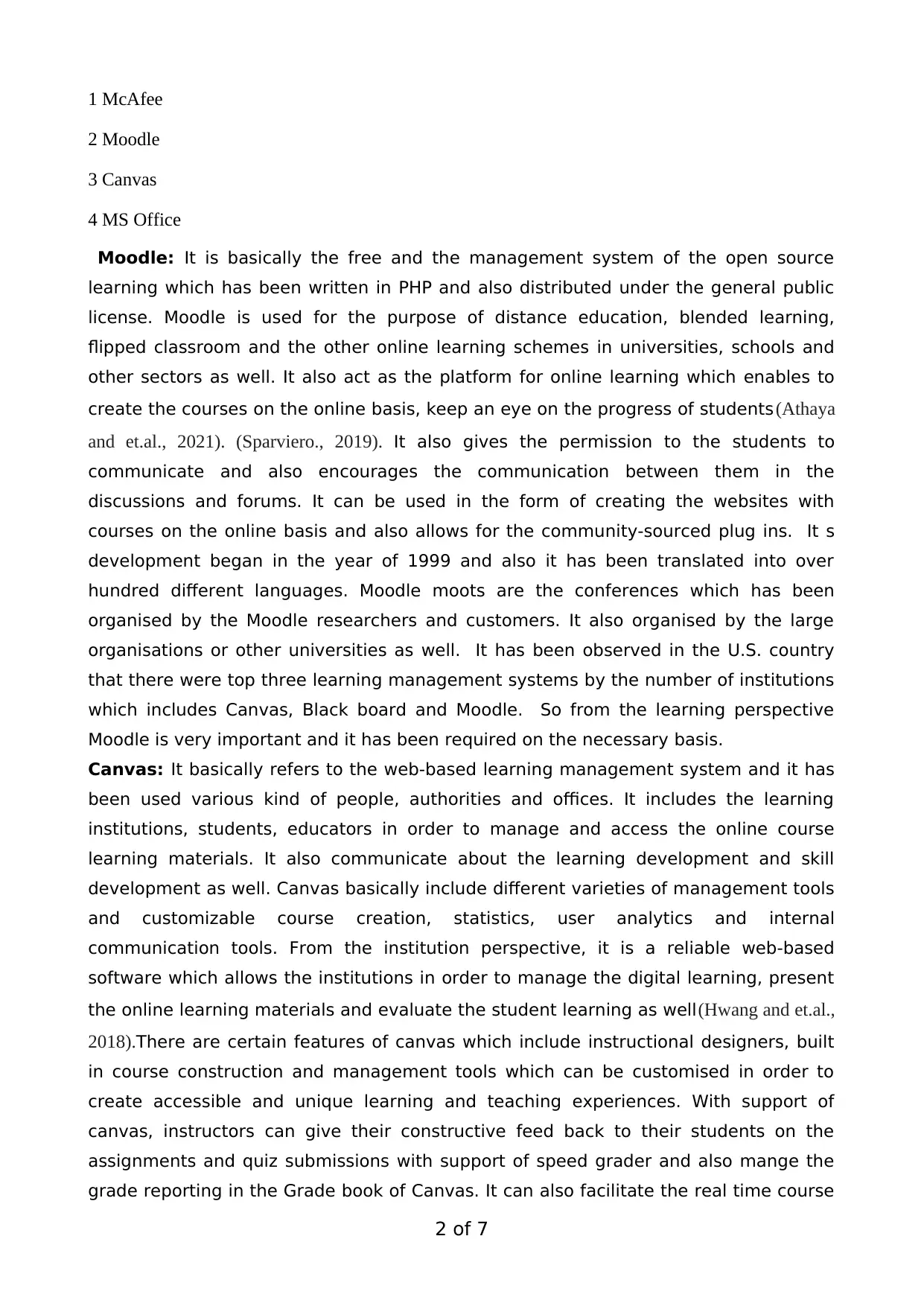
1 McAfee
2 Moodle
3 Canvas
4 MS Office
Moodle: It is basically the free and the management system of the open source
learning which has been written in PHP and also distributed under the general public
license. Moodle is used for the purpose of distance education, blended learning,
flipped classroom and the other online learning schemes in universities, schools and
other sectors as well. It also act as the platform for online learning which enables to
create the courses on the online basis, keep an eye on the progress of students (Athaya
and et.al., 2021). (Sparviero., 2019). It also gives the permission to the students to
communicate and also encourages the communication between them in the
discussions and forums. It can be used in the form of creating the websites with
courses on the online basis and also allows for the community-sourced plug ins. It s
development began in the year of 1999 and also it has been translated into over
hundred different languages. Moodle moots are the conferences which has been
organised by the Moodle researchers and customers. It also organised by the large
organisations or other universities as well. It has been observed in the U.S. country
that there were top three learning management systems by the number of institutions
which includes Canvas, Black board and Moodle. So from the learning perspective
Moodle is very important and it has been required on the necessary basis.
Canvas: It basically refers to the web-based learning management system and it has
been used various kind of people, authorities and offices. It includes the learning
institutions, students, educators in order to manage and access the online course
learning materials. It also communicate about the learning development and skill
development as well. Canvas basically include different varieties of management tools
and customizable course creation, statistics, user analytics and internal
communication tools. From the institution perspective, it is a reliable web-based
software which allows the institutions in order to manage the digital learning, present
the online learning materials and evaluate the student learning as well(Hwang and et.al.,
2018).There are certain features of canvas which include instructional designers, built
in course construction and management tools which can be customised in order to
create accessible and unique learning and teaching experiences. With support of
canvas, instructors can give their constructive feed back to their students on the
assignments and quiz submissions with support of speed grader and also mange the
grade reporting in the Grade book of Canvas. It can also facilitate the real time course
2 of 7
2 Moodle
3 Canvas
4 MS Office
Moodle: It is basically the free and the management system of the open source
learning which has been written in PHP and also distributed under the general public
license. Moodle is used for the purpose of distance education, blended learning,
flipped classroom and the other online learning schemes in universities, schools and
other sectors as well. It also act as the platform for online learning which enables to
create the courses on the online basis, keep an eye on the progress of students (Athaya
and et.al., 2021). (Sparviero., 2019). It also gives the permission to the students to
communicate and also encourages the communication between them in the
discussions and forums. It can be used in the form of creating the websites with
courses on the online basis and also allows for the community-sourced plug ins. It s
development began in the year of 1999 and also it has been translated into over
hundred different languages. Moodle moots are the conferences which has been
organised by the Moodle researchers and customers. It also organised by the large
organisations or other universities as well. It has been observed in the U.S. country
that there were top three learning management systems by the number of institutions
which includes Canvas, Black board and Moodle. So from the learning perspective
Moodle is very important and it has been required on the necessary basis.
Canvas: It basically refers to the web-based learning management system and it has
been used various kind of people, authorities and offices. It includes the learning
institutions, students, educators in order to manage and access the online course
learning materials. It also communicate about the learning development and skill
development as well. Canvas basically include different varieties of management tools
and customizable course creation, statistics, user analytics and internal
communication tools. From the institution perspective, it is a reliable web-based
software which allows the institutions in order to manage the digital learning, present
the online learning materials and evaluate the student learning as well(Hwang and et.al.,
2018).There are certain features of canvas which include instructional designers, built
in course construction and management tools which can be customised in order to
create accessible and unique learning and teaching experiences. With support of
canvas, instructors can give their constructive feed back to their students on the
assignments and quiz submissions with support of speed grader and also mange the
grade reporting in the Grade book of Canvas. It can also facilitate the real time course
2 of 7
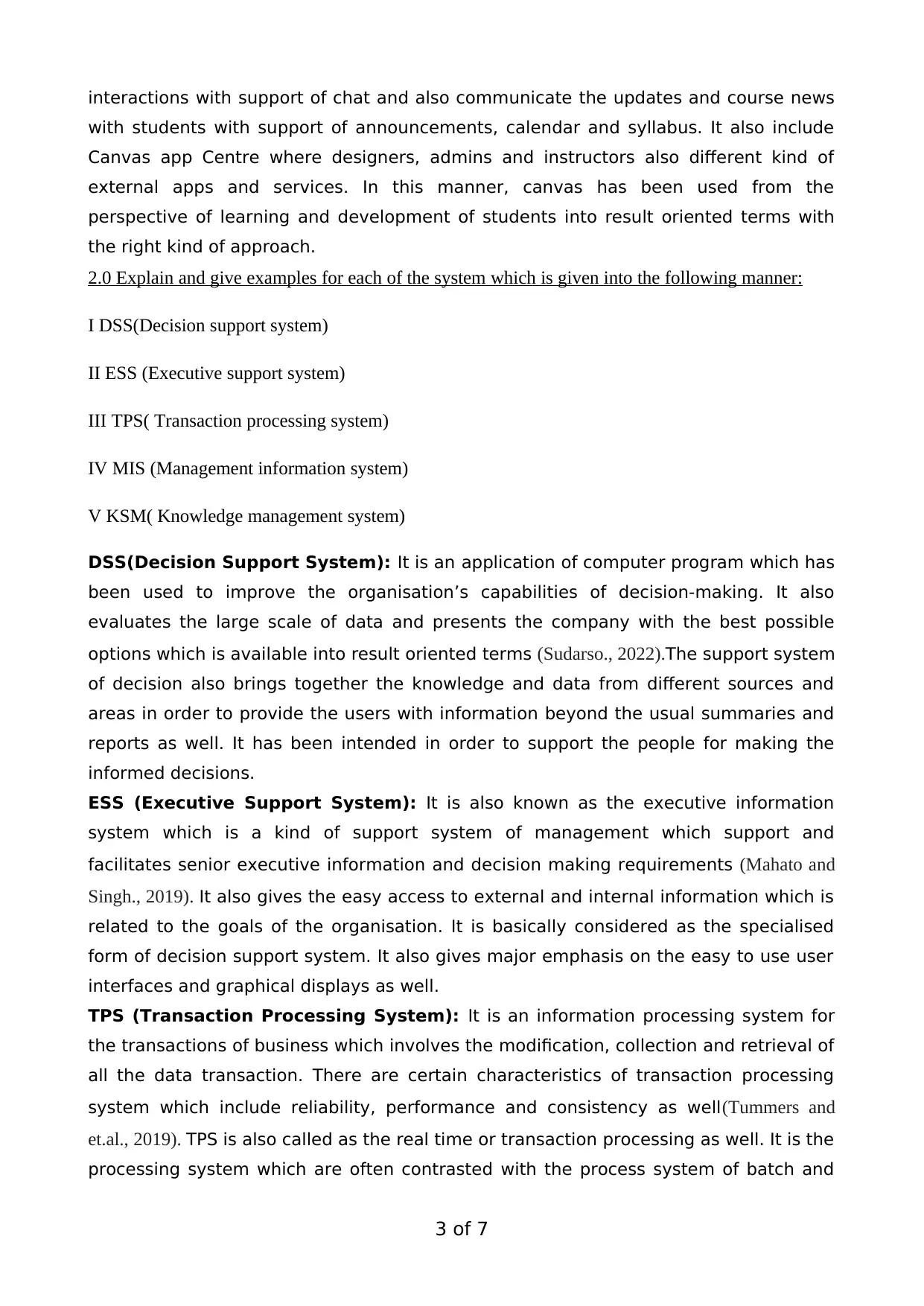
interactions with support of chat and also communicate the updates and course news
with students with support of announcements, calendar and syllabus. It also include
Canvas app Centre where designers, admins and instructors also different kind of
external apps and services. In this manner, canvas has been used from the
perspective of learning and development of students into result oriented terms with
the right kind of approach.
2.0 Explain and give examples for each of the system which is given into the following manner:
I DSS(Decision support system)
II ESS (Executive support system)
III TPS( Transaction processing system)
IV MIS (Management information system)
V KSM( Knowledge management system)
DSS(Decision Support System): It is an application of computer program which has
been used to improve the organisation’s capabilities of decision-making. It also
evaluates the large scale of data and presents the company with the best possible
options which is available into result oriented terms (Sudarso., 2022).The support system
of decision also brings together the knowledge and data from different sources and
areas in order to provide the users with information beyond the usual summaries and
reports as well. It has been intended in order to support the people for making the
informed decisions.
ESS (Executive Support System): It is also known as the executive information
system which is a kind of support system of management which support and
facilitates senior executive information and decision making requirements (Mahato and
Singh., 2019). It also gives the easy access to external and internal information which is
related to the goals of the organisation. It is basically considered as the specialised
form of decision support system. It also gives major emphasis on the easy to use user
interfaces and graphical displays as well.
TPS (Transaction Processing System): It is an information processing system for
the transactions of business which involves the modification, collection and retrieval of
all the data transaction. There are certain characteristics of transaction processing
system which include reliability, performance and consistency as well(Tummers and
et.al., 2019). TPS is also called as the real time or transaction processing as well. It is the
processing system which are often contrasted with the process system of batch and
3 of 7
with students with support of announcements, calendar and syllabus. It also include
Canvas app Centre where designers, admins and instructors also different kind of
external apps and services. In this manner, canvas has been used from the
perspective of learning and development of students into result oriented terms with
the right kind of approach.
2.0 Explain and give examples for each of the system which is given into the following manner:
I DSS(Decision support system)
II ESS (Executive support system)
III TPS( Transaction processing system)
IV MIS (Management information system)
V KSM( Knowledge management system)
DSS(Decision Support System): It is an application of computer program which has
been used to improve the organisation’s capabilities of decision-making. It also
evaluates the large scale of data and presents the company with the best possible
options which is available into result oriented terms (Sudarso., 2022).The support system
of decision also brings together the knowledge and data from different sources and
areas in order to provide the users with information beyond the usual summaries and
reports as well. It has been intended in order to support the people for making the
informed decisions.
ESS (Executive Support System): It is also known as the executive information
system which is a kind of support system of management which support and
facilitates senior executive information and decision making requirements (Mahato and
Singh., 2019). It also gives the easy access to external and internal information which is
related to the goals of the organisation. It is basically considered as the specialised
form of decision support system. It also gives major emphasis on the easy to use user
interfaces and graphical displays as well.
TPS (Transaction Processing System): It is an information processing system for
the transactions of business which involves the modification, collection and retrieval of
all the data transaction. There are certain characteristics of transaction processing
system which include reliability, performance and consistency as well(Tummers and
et.al., 2019). TPS is also called as the real time or transaction processing as well. It is the
processing system which are often contrasted with the process system of batch and
3 of 7
⊘ This is a preview!⊘
Do you want full access?
Subscribe today to unlock all pages.

Trusted by 1+ million students worldwide
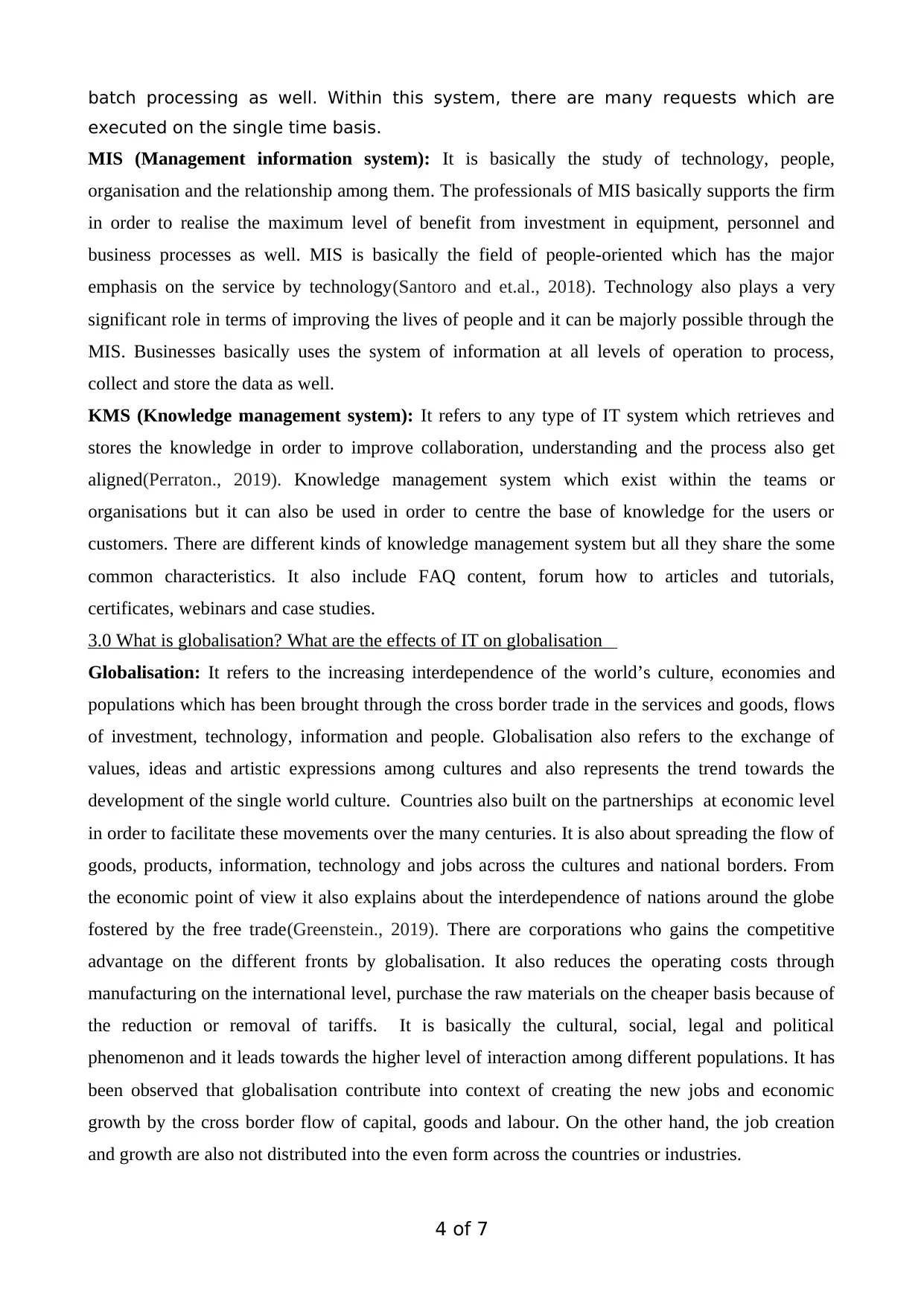
batch processing as well. Within this system, there are many requests which are
executed on the single time basis.
MIS (Management information system): It is basically the study of technology, people,
organisation and the relationship among them. The professionals of MIS basically supports the firm
in order to realise the maximum level of benefit from investment in equipment, personnel and
business processes as well. MIS is basically the field of people-oriented which has the major
emphasis on the service by technology(Santoro and et.al., 2018). Technology also plays a very
significant role in terms of improving the lives of people and it can be majorly possible through the
MIS. Businesses basically uses the system of information at all levels of operation to process,
collect and store the data as well.
KMS (Knowledge management system): It refers to any type of IT system which retrieves and
stores the knowledge in order to improve collaboration, understanding and the process also get
aligned(Perraton., 2019). Knowledge management system which exist within the teams or
organisations but it can also be used in order to centre the base of knowledge for the users or
customers. There are different kinds of knowledge management system but all they share the some
common characteristics. It also include FAQ content, forum how to articles and tutorials,
certificates, webinars and case studies.
3.0 What is globalisation? What are the effects of IT on globalisation
Globalisation: It refers to the increasing interdependence of the world’s culture, economies and
populations which has been brought through the cross border trade in the services and goods, flows
of investment, technology, information and people. Globalisation also refers to the exchange of
values, ideas and artistic expressions among cultures and also represents the trend towards the
development of the single world culture. Countries also built on the partnerships at economic level
in order to facilitate these movements over the many centuries. It is also about spreading the flow of
goods, products, information, technology and jobs across the cultures and national borders. From
the economic point of view it also explains about the interdependence of nations around the globe
fostered by the free trade(Greenstein., 2019). There are corporations who gains the competitive
advantage on the different fronts by globalisation. It also reduces the operating costs through
manufacturing on the international level, purchase the raw materials on the cheaper basis because of
the reduction or removal of tariffs. It is basically the cultural, social, legal and political
phenomenon and it leads towards the higher level of interaction among different populations. It has
been observed that globalisation contribute into context of creating the new jobs and economic
growth by the cross border flow of capital, goods and labour. On the other hand, the job creation
and growth are also not distributed into the even form across the countries or industries.
4 of 7
executed on the single time basis.
MIS (Management information system): It is basically the study of technology, people,
organisation and the relationship among them. The professionals of MIS basically supports the firm
in order to realise the maximum level of benefit from investment in equipment, personnel and
business processes as well. MIS is basically the field of people-oriented which has the major
emphasis on the service by technology(Santoro and et.al., 2018). Technology also plays a very
significant role in terms of improving the lives of people and it can be majorly possible through the
MIS. Businesses basically uses the system of information at all levels of operation to process,
collect and store the data as well.
KMS (Knowledge management system): It refers to any type of IT system which retrieves and
stores the knowledge in order to improve collaboration, understanding and the process also get
aligned(Perraton., 2019). Knowledge management system which exist within the teams or
organisations but it can also be used in order to centre the base of knowledge for the users or
customers. There are different kinds of knowledge management system but all they share the some
common characteristics. It also include FAQ content, forum how to articles and tutorials,
certificates, webinars and case studies.
3.0 What is globalisation? What are the effects of IT on globalisation
Globalisation: It refers to the increasing interdependence of the world’s culture, economies and
populations which has been brought through the cross border trade in the services and goods, flows
of investment, technology, information and people. Globalisation also refers to the exchange of
values, ideas and artistic expressions among cultures and also represents the trend towards the
development of the single world culture. Countries also built on the partnerships at economic level
in order to facilitate these movements over the many centuries. It is also about spreading the flow of
goods, products, information, technology and jobs across the cultures and national borders. From
the economic point of view it also explains about the interdependence of nations around the globe
fostered by the free trade(Greenstein., 2019). There are corporations who gains the competitive
advantage on the different fronts by globalisation. It also reduces the operating costs through
manufacturing on the international level, purchase the raw materials on the cheaper basis because of
the reduction or removal of tariffs. It is basically the cultural, social, legal and political
phenomenon and it leads towards the higher level of interaction among different populations. It has
been observed that globalisation contribute into context of creating the new jobs and economic
growth by the cross border flow of capital, goods and labour. On the other hand, the job creation
and growth are also not distributed into the even form across the countries or industries.
4 of 7
Paraphrase This Document
Need a fresh take? Get an instant paraphrase of this document with our AI Paraphraser
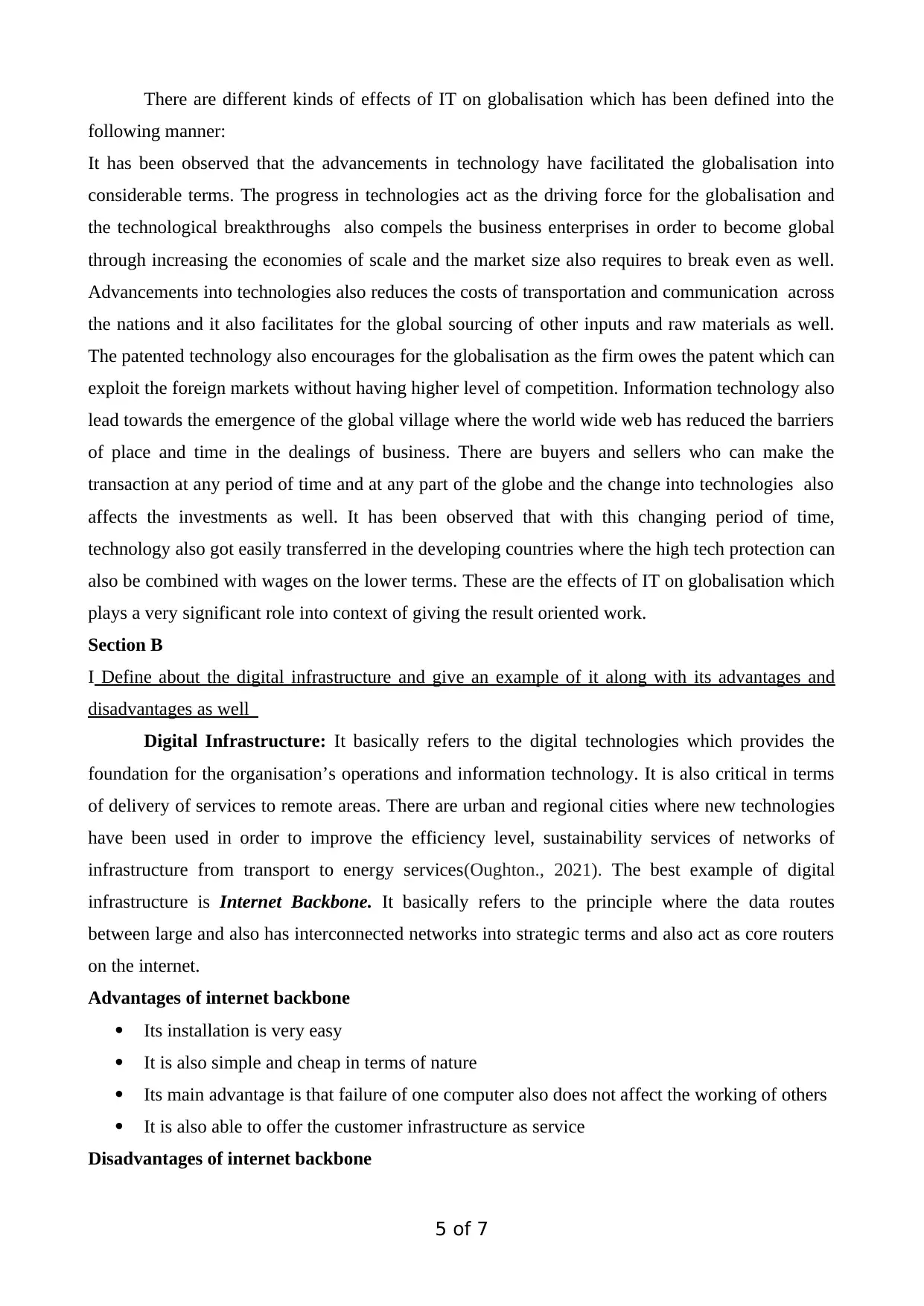
There are different kinds of effects of IT on globalisation which has been defined into the
following manner:
It has been observed that the advancements in technology have facilitated the globalisation into
considerable terms. The progress in technologies act as the driving force for the globalisation and
the technological breakthroughs also compels the business enterprises in order to become global
through increasing the economies of scale and the market size also requires to break even as well.
Advancements into technologies also reduces the costs of transportation and communication across
the nations and it also facilitates for the global sourcing of other inputs and raw materials as well.
The patented technology also encourages for the globalisation as the firm owes the patent which can
exploit the foreign markets without having higher level of competition. Information technology also
lead towards the emergence of the global village where the world wide web has reduced the barriers
of place and time in the dealings of business. There are buyers and sellers who can make the
transaction at any period of time and at any part of the globe and the change into technologies also
affects the investments as well. It has been observed that with this changing period of time,
technology also got easily transferred in the developing countries where the high tech protection can
also be combined with wages on the lower terms. These are the effects of IT on globalisation which
plays a very significant role into context of giving the result oriented work.
Section B
I Define about the digital infrastructure and give an example of it along with its advantages and
disadvantages as well
Digital Infrastructure: It basically refers to the digital technologies which provides the
foundation for the organisation’s operations and information technology. It is also critical in terms
of delivery of services to remote areas. There are urban and regional cities where new technologies
have been used in order to improve the efficiency level, sustainability services of networks of
infrastructure from transport to energy services(Oughton., 2021). The best example of digital
infrastructure is Internet Backbone. It basically refers to the principle where the data routes
between large and also has interconnected networks into strategic terms and also act as core routers
on the internet.
Advantages of internet backbone
Its installation is very easy
It is also simple and cheap in terms of nature
Its main advantage is that failure of one computer also does not affect the working of others
It is also able to offer the customer infrastructure as service
Disadvantages of internet backbone
5 of 7
following manner:
It has been observed that the advancements in technology have facilitated the globalisation into
considerable terms. The progress in technologies act as the driving force for the globalisation and
the technological breakthroughs also compels the business enterprises in order to become global
through increasing the economies of scale and the market size also requires to break even as well.
Advancements into technologies also reduces the costs of transportation and communication across
the nations and it also facilitates for the global sourcing of other inputs and raw materials as well.
The patented technology also encourages for the globalisation as the firm owes the patent which can
exploit the foreign markets without having higher level of competition. Information technology also
lead towards the emergence of the global village where the world wide web has reduced the barriers
of place and time in the dealings of business. There are buyers and sellers who can make the
transaction at any period of time and at any part of the globe and the change into technologies also
affects the investments as well. It has been observed that with this changing period of time,
technology also got easily transferred in the developing countries where the high tech protection can
also be combined with wages on the lower terms. These are the effects of IT on globalisation which
plays a very significant role into context of giving the result oriented work.
Section B
I Define about the digital infrastructure and give an example of it along with its advantages and
disadvantages as well
Digital Infrastructure: It basically refers to the digital technologies which provides the
foundation for the organisation’s operations and information technology. It is also critical in terms
of delivery of services to remote areas. There are urban and regional cities where new technologies
have been used in order to improve the efficiency level, sustainability services of networks of
infrastructure from transport to energy services(Oughton., 2021). The best example of digital
infrastructure is Internet Backbone. It basically refers to the principle where the data routes
between large and also has interconnected networks into strategic terms and also act as core routers
on the internet.
Advantages of internet backbone
Its installation is very easy
It is also simple and cheap in terms of nature
Its main advantage is that failure of one computer also does not affect the working of others
It is also able to offer the customer infrastructure as service
Disadvantages of internet backbone
5 of 7
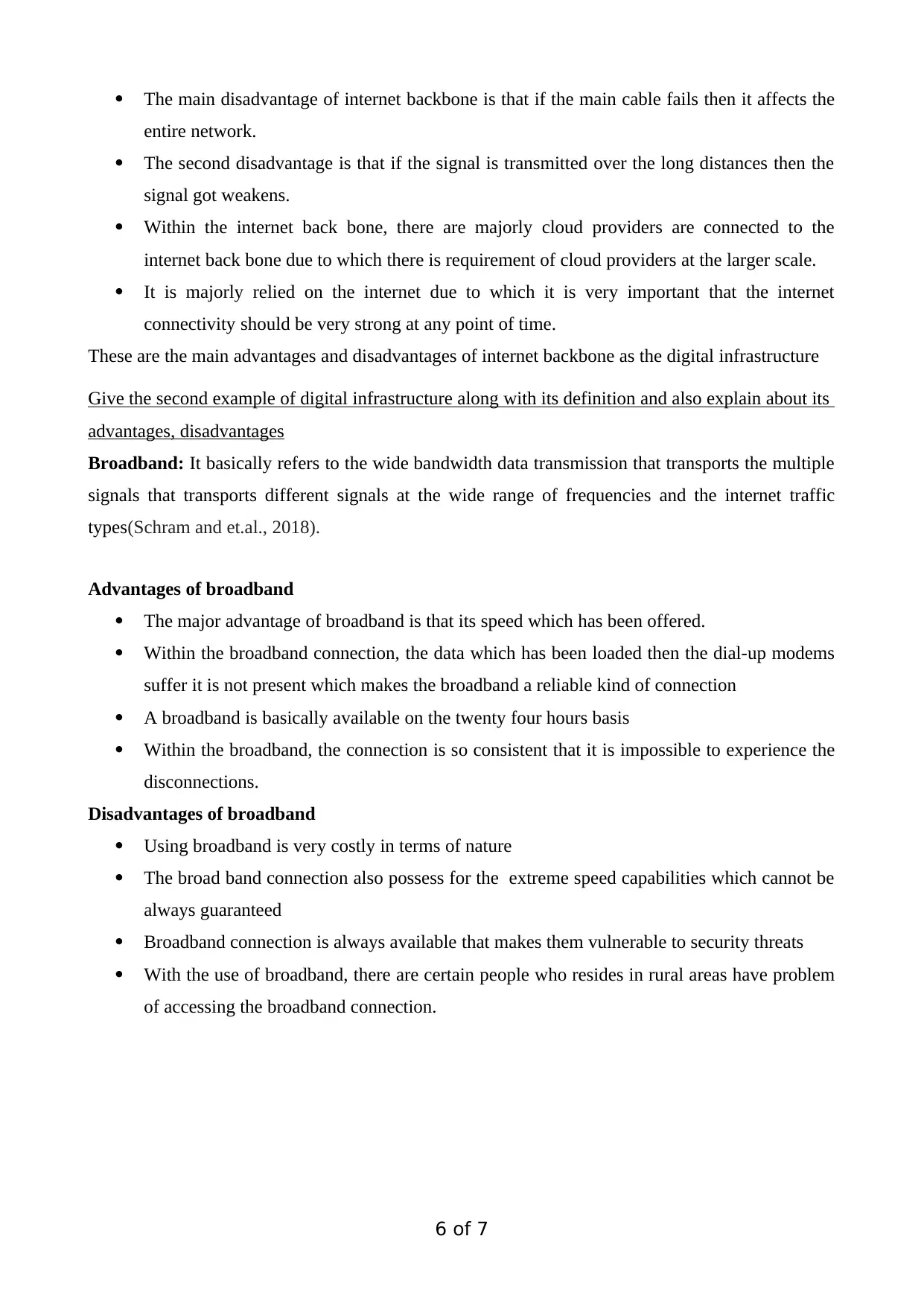
The main disadvantage of internet backbone is that if the main cable fails then it affects the
entire network.
The second disadvantage is that if the signal is transmitted over the long distances then the
signal got weakens.
Within the internet back bone, there are majorly cloud providers are connected to the
internet back bone due to which there is requirement of cloud providers at the larger scale.
It is majorly relied on the internet due to which it is very important that the internet
connectivity should be very strong at any point of time.
These are the main advantages and disadvantages of internet backbone as the digital infrastructure
Give the second example of digital infrastructure along with its definition and also explain about its
advantages, disadvantages
Broadband: It basically refers to the wide bandwidth data transmission that transports the multiple
signals that transports different signals at the wide range of frequencies and the internet traffic
types(Schram and et.al., 2018).
Advantages of broadband
The major advantage of broadband is that its speed which has been offered.
Within the broadband connection, the data which has been loaded then the dial-up modems
suffer it is not present which makes the broadband a reliable kind of connection
A broadband is basically available on the twenty four hours basis
Within the broadband, the connection is so consistent that it is impossible to experience the
disconnections.
Disadvantages of broadband
Using broadband is very costly in terms of nature
The broad band connection also possess for the extreme speed capabilities which cannot be
always guaranteed
Broadband connection is always available that makes them vulnerable to security threats
With the use of broadband, there are certain people who resides in rural areas have problem
of accessing the broadband connection.
6 of 7
entire network.
The second disadvantage is that if the signal is transmitted over the long distances then the
signal got weakens.
Within the internet back bone, there are majorly cloud providers are connected to the
internet back bone due to which there is requirement of cloud providers at the larger scale.
It is majorly relied on the internet due to which it is very important that the internet
connectivity should be very strong at any point of time.
These are the main advantages and disadvantages of internet backbone as the digital infrastructure
Give the second example of digital infrastructure along with its definition and also explain about its
advantages, disadvantages
Broadband: It basically refers to the wide bandwidth data transmission that transports the multiple
signals that transports different signals at the wide range of frequencies and the internet traffic
types(Schram and et.al., 2018).
Advantages of broadband
The major advantage of broadband is that its speed which has been offered.
Within the broadband connection, the data which has been loaded then the dial-up modems
suffer it is not present which makes the broadband a reliable kind of connection
A broadband is basically available on the twenty four hours basis
Within the broadband, the connection is so consistent that it is impossible to experience the
disconnections.
Disadvantages of broadband
Using broadband is very costly in terms of nature
The broad band connection also possess for the extreme speed capabilities which cannot be
always guaranteed
Broadband connection is always available that makes them vulnerable to security threats
With the use of broadband, there are certain people who resides in rural areas have problem
of accessing the broadband connection.
6 of 7
⊘ This is a preview!⊘
Do you want full access?
Subscribe today to unlock all pages.

Trusted by 1+ million students worldwide
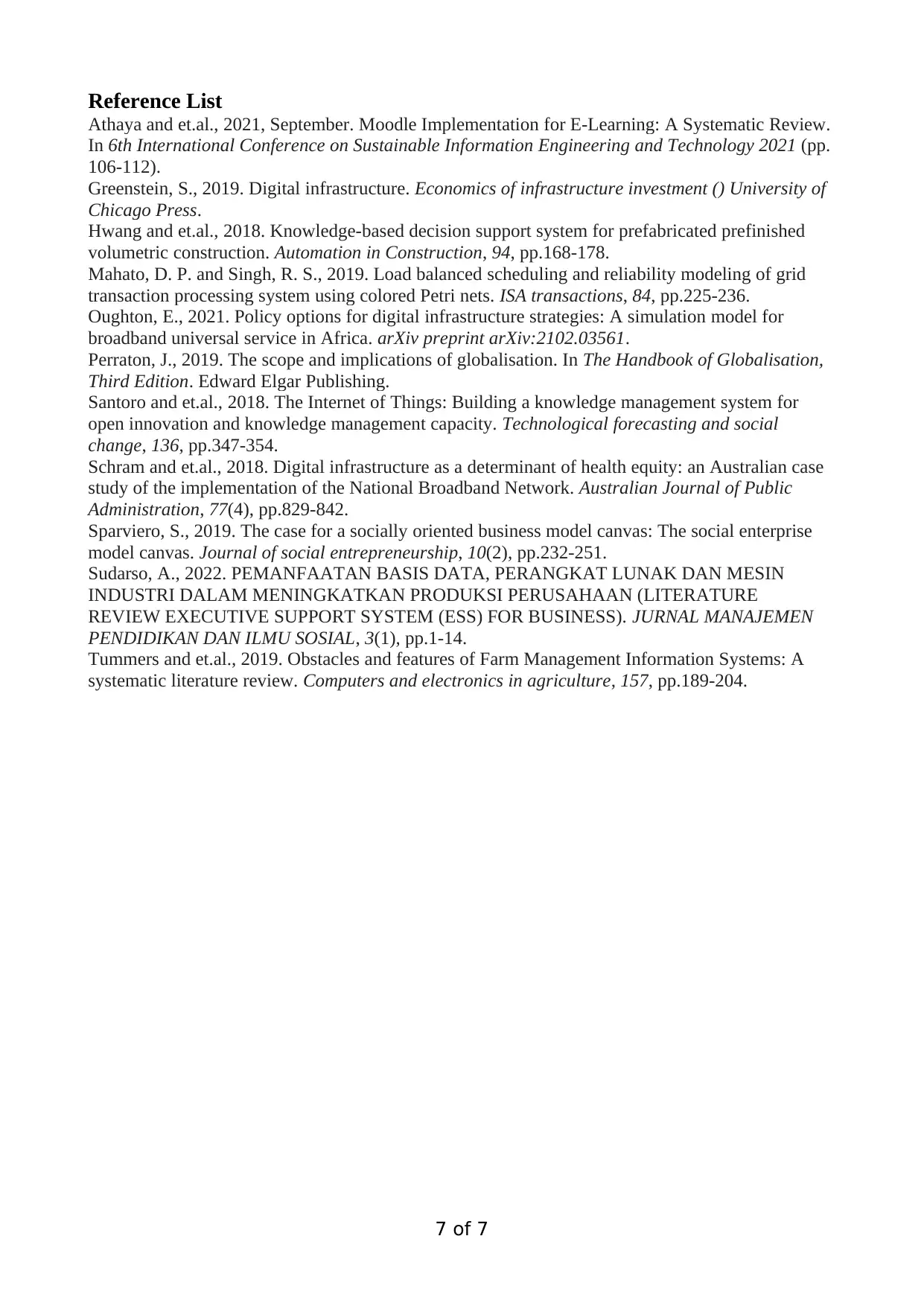
Reference List
Athaya and et.al., 2021, September. Moodle Implementation for E-Learning: A Systematic Review.
In 6th International Conference on Sustainable Information Engineering and Technology 2021 (pp.
106-112).
Greenstein, S., 2019. Digital infrastructure. Economics of infrastructure investment () University of
Chicago Press.
Hwang and et.al., 2018. Knowledge-based decision support system for prefabricated prefinished
volumetric construction. Automation in Construction, 94, pp.168-178.
Mahato, D. P. and Singh, R. S., 2019. Load balanced scheduling and reliability modeling of grid
transaction processing system using colored Petri nets. ISA transactions, 84, pp.225-236.
Oughton, E., 2021. Policy options for digital infrastructure strategies: A simulation model for
broadband universal service in Africa. arXiv preprint arXiv:2102.03561.
Perraton, J., 2019. The scope and implications of globalisation. In The Handbook of Globalisation,
Third Edition. Edward Elgar Publishing.
Santoro and et.al., 2018. The Internet of Things: Building a knowledge management system for
open innovation and knowledge management capacity. Technological forecasting and social
change, 136, pp.347-354.
Schram and et.al., 2018. Digital infrastructure as a determinant of health equity: an Australian case
study of the implementation of the National Broadband Network. Australian Journal of Public
Administration, 77(4), pp.829-842.
Sparviero, S., 2019. The case for a socially oriented business model canvas: The social enterprise
model canvas. Journal of social entrepreneurship, 10(2), pp.232-251.
Sudarso, A., 2022. PEMANFAATAN BASIS DATA, PERANGKAT LUNAK DAN MESIN
INDUSTRI DALAM MENINGKATKAN PRODUKSI PERUSAHAAN (LITERATURE
REVIEW EXECUTIVE SUPPORT SYSTEM (ESS) FOR BUSINESS). JURNAL MANAJEMEN
PENDIDIKAN DAN ILMU SOSIAL, 3(1), pp.1-14.
Tummers and et.al., 2019. Obstacles and features of Farm Management Information Systems: A
systematic literature review. Computers and electronics in agriculture, 157, pp.189-204.
7 of 7
Athaya and et.al., 2021, September. Moodle Implementation for E-Learning: A Systematic Review.
In 6th International Conference on Sustainable Information Engineering and Technology 2021 (pp.
106-112).
Greenstein, S., 2019. Digital infrastructure. Economics of infrastructure investment () University of
Chicago Press.
Hwang and et.al., 2018. Knowledge-based decision support system for prefabricated prefinished
volumetric construction. Automation in Construction, 94, pp.168-178.
Mahato, D. P. and Singh, R. S., 2019. Load balanced scheduling and reliability modeling of grid
transaction processing system using colored Petri nets. ISA transactions, 84, pp.225-236.
Oughton, E., 2021. Policy options for digital infrastructure strategies: A simulation model for
broadband universal service in Africa. arXiv preprint arXiv:2102.03561.
Perraton, J., 2019. The scope and implications of globalisation. In The Handbook of Globalisation,
Third Edition. Edward Elgar Publishing.
Santoro and et.al., 2018. The Internet of Things: Building a knowledge management system for
open innovation and knowledge management capacity. Technological forecasting and social
change, 136, pp.347-354.
Schram and et.al., 2018. Digital infrastructure as a determinant of health equity: an Australian case
study of the implementation of the National Broadband Network. Australian Journal of Public
Administration, 77(4), pp.829-842.
Sparviero, S., 2019. The case for a socially oriented business model canvas: The social enterprise
model canvas. Journal of social entrepreneurship, 10(2), pp.232-251.
Sudarso, A., 2022. PEMANFAATAN BASIS DATA, PERANGKAT LUNAK DAN MESIN
INDUSTRI DALAM MENINGKATKAN PRODUKSI PERUSAHAAN (LITERATURE
REVIEW EXECUTIVE SUPPORT SYSTEM (ESS) FOR BUSINESS). JURNAL MANAJEMEN
PENDIDIKAN DAN ILMU SOSIAL, 3(1), pp.1-14.
Tummers and et.al., 2019. Obstacles and features of Farm Management Information Systems: A
systematic literature review. Computers and electronics in agriculture, 157, pp.189-204.
7 of 7
1 out of 7
Related Documents
Your All-in-One AI-Powered Toolkit for Academic Success.
+13062052269
info@desklib.com
Available 24*7 on WhatsApp / Email
![[object Object]](/_next/static/media/star-bottom.7253800d.svg)
Unlock your academic potential
Copyright © 2020–2025 A2Z Services. All Rights Reserved. Developed and managed by ZUCOL.





